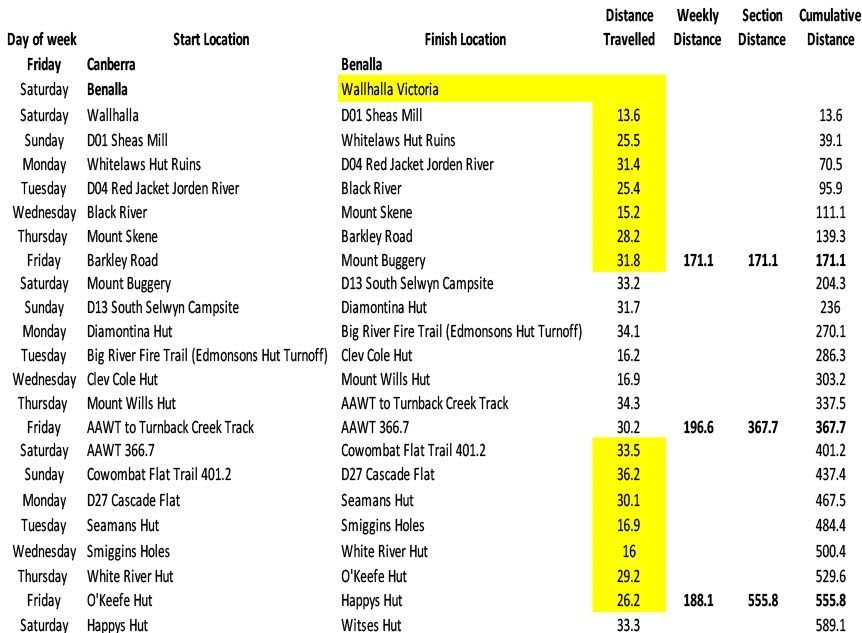2020 Australian Alps Walking Track
 2020 AAWT Spreadsheet
2020 AAWT Spreadsheet
There’s an old saying of ‘Fail to plan, plan to fail’ so over Easter of this year I started the detailed planning for my Australian Alps Walking Track (AAWT) journey using a multi-page spreadsheet I have progressively refined over the past six years. This spreadsheet includes food, equipment, water sources, social media posting schedule, and other ancillary information and details like the location of ATMs etc. While this planning may seem obsessive to many, there’s a valid reason behind it. The AAWT is a track that involves large areas of remote travel with minimal phone signal and requires food drops/caching; winging it is just not an option. In addition, this level of planning means I can provide a detailed itinerary to family and friends so they will know where I will be at a given point in time. This information can also be used in the unlikely event I fail to check-in as agreed or if I need assistance, and thereby narrow down any potential search area. For me, the planning side of a hike is just as enjoyable as the hike itself. It provides a mental challenge and it pushes me into learning as much about the track as possible without actually going on trail.
So how do I work out my detailed itinerary? Between 2015-2018 I set myself the task of finding out what my limits actually are. How far can I walk in a single day? How far can I walk over multiple days? What speed do I travel at? What’s my ideal pack weight? What’s my ideal body weight? These are all questions I know the answer to and as a result, I can work out how far I can comfortably travel in a day which allows to identify daily campsites.
I have done a fair amount of hiking in the alpine area close to Canberra including the closest 112 km section of the AAWT and from this experience I know my average comfortable travelling speed with a full pack is 3.75 km per hour. From a purely arbitrary perspective on long distance hikes, I like to average 32 km (20 miles) per day but given the hillier nature of this track, I have reduced that by about 20% and plan on averaging around 26 km per day. Some days will be longer and some shorter but this average daily distance means my hike will be 26 days. While I’m an obsessive planner, I also believe that for one reason or another your plans need to be flexible and as such I have an additional six days up my sleeve should things not go to plan.
Stage one of my planning was to run through my trip, identifying camping sites based purely on this daily average and using the Guthook App. This first run through was purely arbitrary and didn’t take into account elevation change, navigation, water sources or the quality of the camping sites.
In stage two I went back to the start and this time I looked at each day on a case by case basis considering elevation changes, water sources, campsites, and where I was likely to finish each day. A good example is the campsite on day 1 at Sheas Mill which is approximately 14 km from the trailhead and sits at the base of the first big incline on the trail which also has a close water source. This is a logical point to finish day 1 and while it makes for a shortish first day, it just makes sense. From there I reworked the rest of the trip in the same manner which meant varying my days, and include some long days and some short days in the mix.
Stage three is underway with consideration of food caching/resupply points. I prefer to carry a maximum of eight days of food at the commencement of a leg so now I need to locate logical resupply points based on my planned hike and the ability to access these points by vehicle.
For now my schedule will stand and every so often I will revisit it to see if it makes sense and of course, tweak it as needed.
There’s an old saying of ‘Fail to plan, plan to fail’ so over Easter of this year I started the detailed planning for my Australian Alps Walking Track (AAWT) journey using a multi-page spreadsheet I have progressively refined over the past six years. This spreadsheet includes food, equipment, water sources, social media posting schedule, and […]